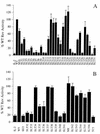Functional analysis of the human immunodeficiency virus type 1 Rev protein oligomerization interface
- PMID: 9525614
- PMCID: PMC109739
- DOI: 10.1128/JVI.72.4.2935-2944.1998
Functional analysis of the human immunodeficiency virus type 1 Rev protein oligomerization interface
Abstract
The expression of human immunodeficiency virus type 1 (HIV-1) structural proteins requires the action of the viral trans-regulatory protein Rev. Rev is a nuclear shuttle protein that directly binds to its cis-acting Rev response element (RRE) RNA target sequence. Subsequent oligomerization of Rev monomers on the RRE and interaction of Rev with a cellular cofactor(s) result in the cytoplasmic accumulation of RRE-containing viral mRNAs. Moreover, Rev by itself is exported from the nucleus to the cytoplasm. Although it has been demonstrated that Rev multimerization is critically required for Rev activity and hence for HIV-1 replication, the number of Rev monomers required to form a trans-activation-competent complex on the RRE is unknown. Here we report a systematic analysis of the putative multimerization domains within the Rev trans-activator protein. We identify the amino acid residues which are part of the proposed single hydrophobic surface patch in the Rev amino terminus that mediates intermolecular interactions. Furthermore, we show that the expression of a multimerization-deficient Rev mutant blocks HIV-1 replication in a trans-dominant (dominant-negative) fashion.
Figures





Similar articles
-
Formation of trans-activation competent HIV-1 Rev:RRE complexes requires the recruitment of multiple protein activation domains.PLoS One. 2012;7(6):e38305. doi: 10.1371/journal.pone.0038305. Epub 2012 Jun 4. PLoS One. 2012. PMID: 22675540 Free PMC article.
-
Exchange of the basic domain of human immunodeficiency virus type 1 Rev for a polyarginine stretch expands the RNA binding specificity, and a minimal arginine cluster is required for optimal RRE RNA binding affinity, nuclear accumulation, and trans-activation.J Virol. 2001 Mar;75(6):2957-71. doi: 10.1128/JVI.75.6.2957-2971.2001. J Virol. 2001. PMID: 11222721 Free PMC article.
-
Human immunodeficiency virus type 1 Rev activation can be achieved without Rev-responsive element RNA if Rev is directed to the target as a Rev/MS2 fusion protein which tethers the MS2 operator RNA.J Virol. 1992 Dec;66(12):7469-80. doi: 10.1128/JVI.66.12.7469-7480.1992. J Virol. 1992. PMID: 1433526 Free PMC article.
-
Nucleocytoplasmic RNA transport in retroviral replication.Results Probl Cell Differ. 2001;34:197-217. doi: 10.1007/978-3-540-40025-7_12. Results Probl Cell Differ. 2001. PMID: 11288676 Review.
-
HIV-1 Rev multimerization: mechanism and insights.Curr HIV Res. 2013 Dec;11(8):623-34. doi: 10.2174/1570162x12666140307094603. Curr HIV Res. 2013. PMID: 24606219 Review.
Cited by
-
Multimer formation is not essential for nuclear export of human T-cell leukemia virus type 1 Rex trans-activator protein.J Virol. 1998 Nov;72(11):8659-68. doi: 10.1128/JVI.72.11.8659-8668.1998. J Virol. 1998. PMID: 9765406 Free PMC article.
-
HIV RGB: Automated Single-Cell Analysis of HIV-1 Rev-Dependent RNA Nuclear Export and Translation Using Image Processing in KNIME.Viruses. 2022 Apr 26;14(5):903. doi: 10.3390/v14050903. Viruses. 2022. PMID: 35632645 Free PMC article.
-
Computational modeling suggests dimerization of equine infectious anemia virus Rev is required for RNA binding.Retrovirology. 2014 Dec 23;11:115. doi: 10.1186/s12977-014-0115-7. Retrovirology. 2014. PMID: 25533001 Free PMC article.
-
Measuring cooperative Rev protein-protein interactions on Rev responsive RNA by fluorescence resonance energy transfer.RNA Biol. 2011 Mar-Apr;8(2):316-24. doi: 10.4161/rna.8.2.13782. Epub 2011 Mar 1. RNA Biol. 2011. PMID: 21358282 Free PMC article.
-
A HIV-1 Tat mutant protein disrupts HIV-1 Rev function by targeting the DEAD-box RNA helicase DDX1.Retrovirology. 2014 Dec 14;11:121. doi: 10.1186/s12977-014-0121-9. Retrovirology. 2014. PMID: 25496916 Free PMC article.
References
-
- Auer M, Gremlich H-U, Seifert J-M, Daly T J, Parslow T G, Casari G, Gstach H. Helix-loop-helix motif in HIV-1 Rev. Biochem. 1994;33:2988–2996. - PubMed
-
- Bartel D P, Zapp M L, Green M R, Szostak J W. HIV-1 Rev regulation involves recognition of non-Watson-Crick base pairs in viral RNA. Cell. 1991;67:529–536. - PubMed
-
- Berger J, Aepinus C, Dobrovnik M, Fleckenstein B, Hauber J, Böhnlein E. Mutational analysis of functional domains in the HIV-1 Rev trans-regulatory protein. Virology. 1991;183:630–635. - PubMed
-
- Berger J, Hauber J, Hauber R, Geiger R, Cullen B R. Secreted placental alkaline phosphatase: a powerful new quantitative indicator of gene expression in eukaryotic cells. Gene. 1988;66:1–10. - PubMed
Publication types
MeSH terms
Substances
LinkOut - more resources
Full Text Sources
Other Literature Sources

